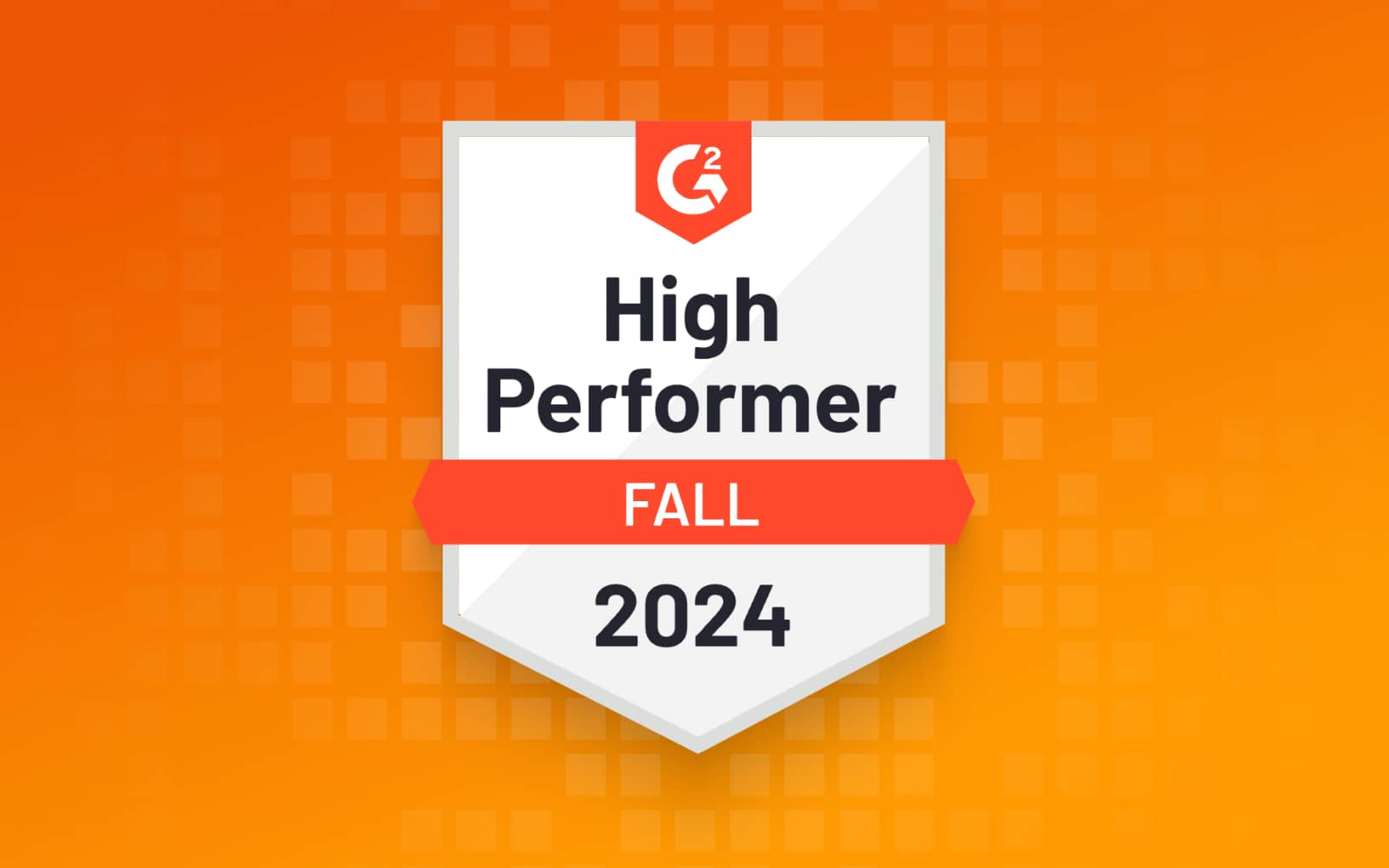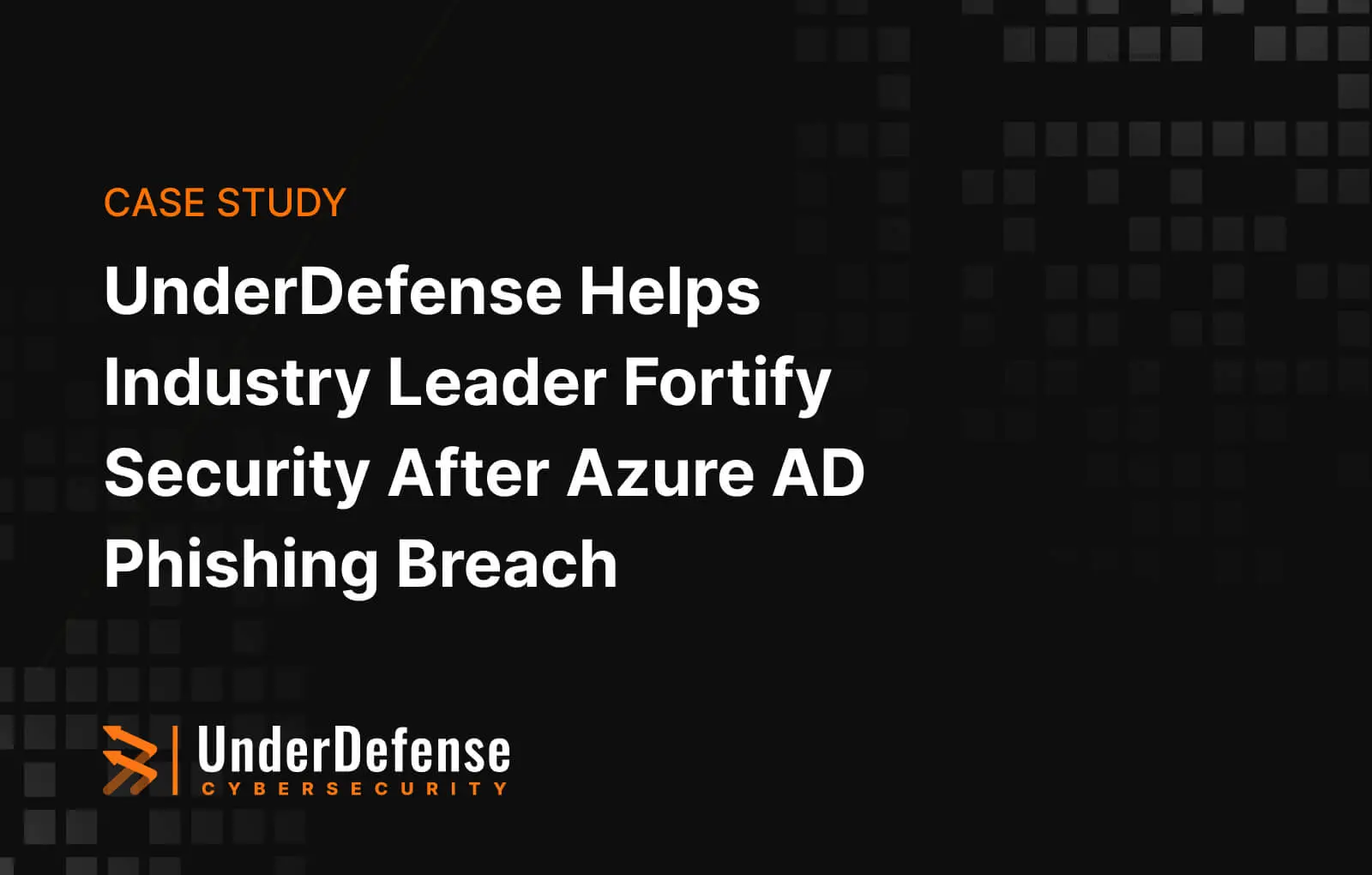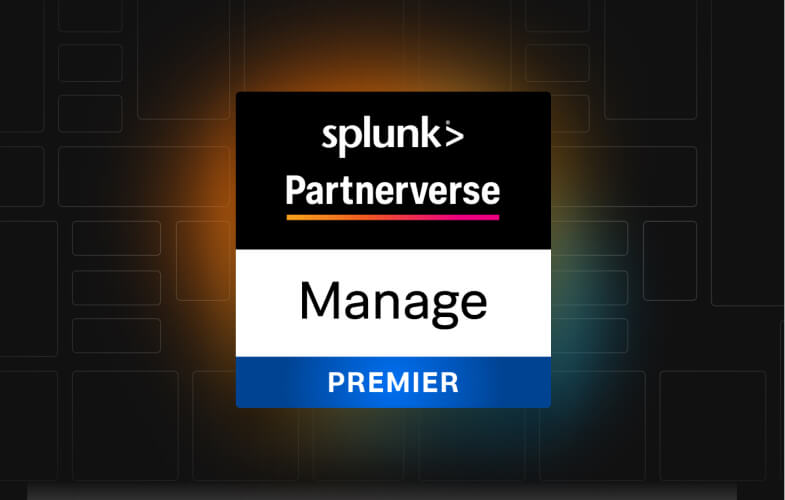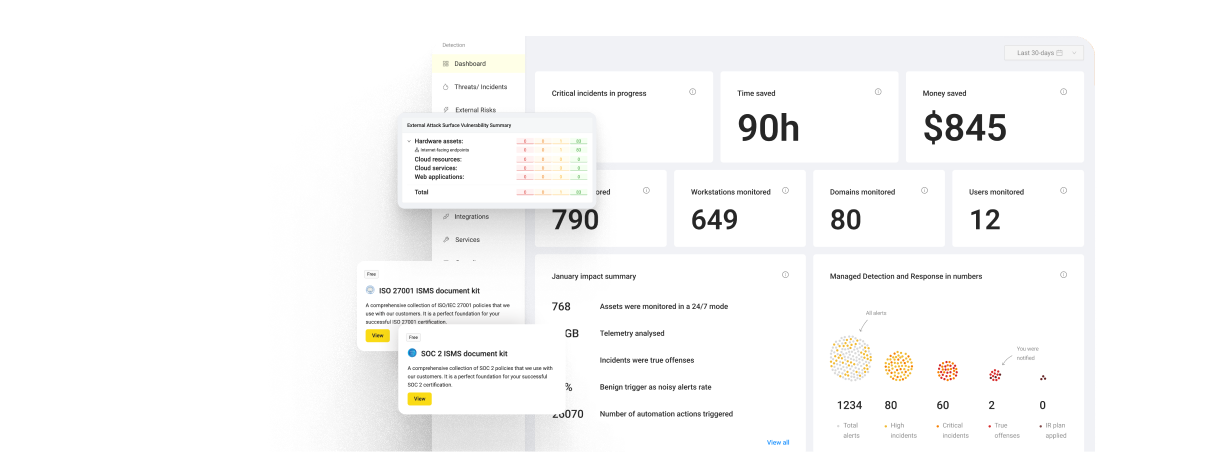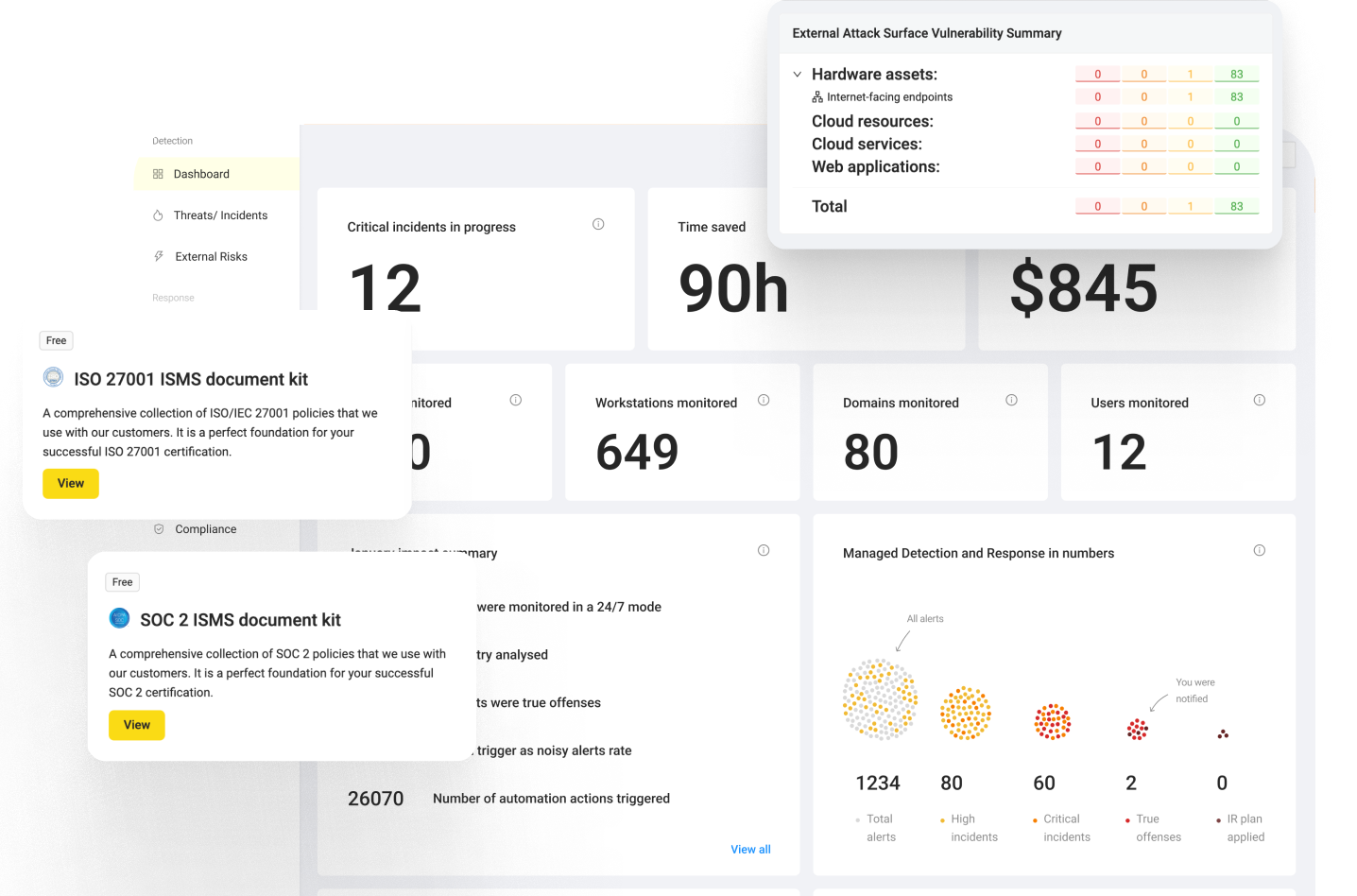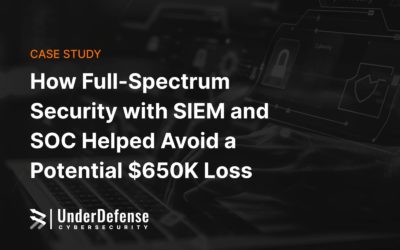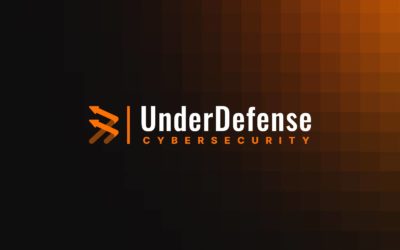These days, more and more organizations are leaning on MDR providers to protect their ever-growing and complex digital environments. With cyber threats getting smarter and the global managed detection and response market expected to hit $2.6 billion by 2027, it’s a good moment to take a closer look at what leading MDR companies bring to the table.
Over the years, we’ve heard the same thing from our customers – picking the right provider isn’t easy. The market is packed with different tools, promises, and buzzwords. So, to make things simpler, we’ve put together a shortlist of managed detection and response vendors—like UnderDefense, Arctic Wolf, and Expel—that stand out and deliver real value.
Top MDR Providers List in 2025
Here are the best MDR companies that offer managed detection and response services to strengthen security in 2025.
- UnderDefense
- Arctic Wolf
- Alert Logic / Fortra
- Expel
- Red Canary
- Proficio
- Cato Networks
- Masergy
- Versa Networks
- Sophos MDR
Details and Features of MDR Providers
1. UnderDefense
UnderDefense is the award-winning cybersecurity team and top-rated company on Gartner and Clutch. Its holistic MDR solutions combine managed threat-hunting and incident response experts with state-of-the-art technologies to predict, prevent, detect, and respond to the most advanced cyberattacks.
The company offers different service delivery models that meet you where you are and scale easily as your business needs grow. You can choose a suitable package and pay only for those services you need today. Such an approach makes the UnderDefense MDR platform the most cost-effective solution for full visibility and complete breach protection.
The main features:
- Quick deployment and seamless integration into your existing IT security stack allow you to get the most out of current tools without overpaying
- Automation of day-to-day security operations from immediate detection to seamless remediation. Prebuilt and custom correlation rules for companies to boost response capabilities, optimize security costs, and deal with alert fatigue
- 24/7 monitoring, threat intelligence, and user behavior analytics to guarantee unprecedented environment visibility, and detect suspicious activity across endpoints, networks, cloud, on-premises, and hybrid environments
- Comprehensive forensics provides insight into the root cause of a security incident, a detailed view of the affected assets within the network, and clear guidance on how to remediate and minimize the consequences for business.
2. Arctic Wolf
Arctic Wolf’s managed detection and response tools offer 24/7 threat monitoring of endpoints, networks, and cloud environments. They empower companies to detect and contain advanced cyberattacks and prevent future attacks with workflow customization and exhaustive threat analysis.
The main features:
- White-glove deployment engagement to minimize confusion, complexity, and time
- Around-the-clock security coverage of major cloud platforms by a dedicated team
- Combination of security industry experience and unique understanding of cloud strategies to guide clients’ ongoing cloud security posture improvement.
3. Alert Logic / Fortra
Alert Logic offers white-glove managed detection and response solutions for SaaS, public cloud, on-premises, and hybrid environments. It was named the leader by IDC and G2 (MDR for enterprises). In March 2022, Fortra acquired Alert Logic to augment the existing cybersecurity resources and enrich its industry portfolio.
The main features:
- Threat intelligence that combines human smarts with industry data, continuous threat research, and machine learning
- Real-time reporting on compliance status, vulnerabilities, risks, remediation activities, and configuration exposures
- Platform scalability to protect the entire attack surface and ensure visibility and security analytics for networks, applications, and endpoints in cloud, hybrid, and on-premises environments.
4. Expel
Expel’s MDR security solutions cover SaaS, Kubernetes, cloud, and on-premises environments with around-the-clock detection and response. The company leverages a software-driven approach to eliminate the noise, allowing clients to dedicate time to what matters most.
The main features:
- Integration with existing tech without agents, SIEM, or new hardware
- Automation of alerts and logs, as well as auto-remediation or full resilience recommendations
- Investigation of suspicious activities by the SOC and further provision of answers to the alerts
- Real-time alerts and comprehensive reports to prevent risks and gain full visibility into the investigation process.
5. Red Canary
Red Canary offers 24/7 MDR security systems for identities, endpoints, networks, cloud, and SaaS. They integrate with many modern security products to make it easier for companies to gain the best value and ROI from their current security investments.
The main features:
- Threat monitoring, detection, and investigation 24/7 applying advanced analytics to telemetry
- Automation and orchestration of playbooks to respond to threats, start remediation, and inform the right people
- Executive reporting to ensure complete transparency and let leaders track ROI and MTTR.
6. Proficio
Proficio’s MDR services leverage AI-based threat hunting, threat intelligence, and cutting-edge technologies to detect attacks effectively and promptly. The company was the first to offer response automation products, and today they propose a holistic set of Security Orchestration Automation and Response (SOAR) solutions
The main features:
- 24/7 security monitoring and alerting
- Integrated threat intelligence and AI-based threat hunting
- Managed endpoint detection and response
- Risk-based vulnerability management
- Automated and semi-automated containment
Proficio’s MDR services leverage AI-based threat hunting, threat intelligence, and cutting-edge technologies to detect attacks effectively and promptly. The company was the first to offer response automation products, and today they propose a holistic set of Security Orchestration Automation and Response (SOAR) solutions
7. Cato Networks
Cato Networks provides a cutting-edge SASE-based MDR platform, offering integrated network and security management. It is known for fast deployment and automates AI-driven threat detection to secure complex networks quickly and efficiently. With a strong focus on real-time network-level threat containment, Cato ensures protection across its wide-ranging SASE solution.
The main features:
- SASE-based solution: Combines network and security management into a single platform, simplifying infrastructure.
- Automated AI threat hunting: Leverages machine learning to detect suspicious activity and anomalies.
- Guided remediation: Provides clear steps for IT teams to contain and remediate threats.
8. Masergy
Missing Features: Lacks a fully integrated customer portal and some GUI functionality.
Masergy offers an AI-powered MDR platform that focuses on proactive threat hunting and securing IoT and network devices. Known for its efficient 24/7 global SOC monitoring, Masergy helps companies prevent malware, ransomware, and other threats across cloud and on-prem environments. It’s a cost-effective solution for companies looking for a reliable security partner that frees up internal resources.
The main features:
- AI-enhanced threat detection: Uses AI to proactively detect and mitigate threats before they escalate.
- Network and IoT security: Protects enterprise devices and IoT infrastructure with real-time visibility.
- Global SOC support: Provides cost-effective 24/7 security monitoring for businesses of all sizes.
9. Versa Networks
Versa Networks brings Zero Trust MDR solutions, perfect for businesses that operate in hybrid or multi-cloud environments. Versa enhances security by offering full visibility into network traffic and ensuring that mobile and remote users are protected. Their MDR services are ideal for organizations that prioritize secure access and network flexibility.
The main features:
- Zero Trust security integration: Ensures that all users and devices are authenticated and authorized, minimizing risks.
- Multi-cloud threat detection: Provides real-time detection across on-prem, private, and public cloud environments.
- Strong security for remote workers: Delivers security solutions designed for mobile and distributed teams.
10. Sophos MDR
Sophos Managed Threat Response (MTR) delivers 24/7 threat monitoring, detection, and response using their Intercept X platform. Sophos offers a fully managed service that handles threat remediation for businesses of all sizes, particularly SMBs.
The main features:
- 24/7 managed threat response
- Full remediation handled by security experts
- Endpoint protection with Intercept X
- Simple deployment for SMBs.
The Role of MDR Solutions in Tomorrow’s Business Protection
We’ve recently discussed MDR and how it differs from EDR and XDR products. Meanwhile, the long list of advantages makes the current popularity of MDR solutions easily explainable. In the Market Guide for Managed Detection and Response Services, Gartner states that by 2025, 60% of companies will actively employ remote threat disruption and containment capabilities offered by MDR service providers, compared to 30% today.
Discover the real benefits of managed detection and response—watch this quick breakdown of MDR in action.
Top 3 challenges MDR vendors solve
1. Lack of human resources
It’s no secret that cybersecurity is facing a tremendous talent gap. Moreover, only a few industries experience the same skill shortages. Deepwatch SecOps Pulse Survey found that in July 2022, there were over 700,000 cybersecurity vacancies in the United States alone. If no corrective measures are taken, the gap will surpass one million by 2025.
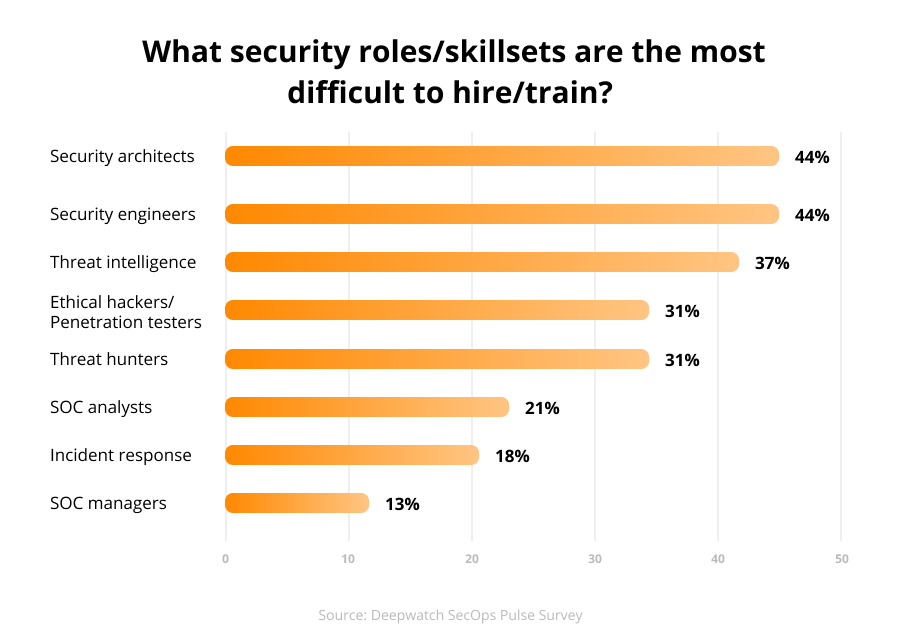
Many organizations have adopted modern security tech to help their understaffed departments address the glooming threat landscape. For instance, the number of security products planned to be implemented in the upcoming 12 months will increase by over 80%. However, such an approach only aggravates the situation since companies lack the resources and expertise to properly deploy, fine-tune, and smoothly orchestrate new tools with other software in place.
2. Alert fatigue
Overwhelmed security teams are the second biggest problem of modern organizations. Reviewing, sorting, and managing a great many alerts coming from all those security technologies require more expertise and resources than companies typically own. Meanwhile, the number of alerts keeps growing along with digital estates and the number of endpoints.

Security teams are forced to deal with the same situation daily, which results in demoralization, burnout, and high attrition rates.
3. Limited budget
Let’s admit that building an internal security operations center (SOC) is time-consuming and costly. Calculating the return on investment is challenging, and positive outcomes are not well-defined.
Building an in-house SOC can take months or even years, leaving your organization vulnerable. MDR services address these challenges, offering immediate solutions for compliance and security.
How to Choose the Best MDR Provider
Managed detection and response solutions come with a wide range of services, and you may not need them all. So, start by analyzing your existing capabilities and identifying the gaps that should be filled. By doing so, you will augment your current security investments and optimize further operating expenses.
Done? Then we’re good to go. Below are five questions that will help you select a reputed MDR service provider.
- What experience and expertise does the managed detection and response provider possess?
- What service delivery models does the MDR security vendor offer? Do any of these options work for you?
- How will the company work with and orchestrate your current security software for effective threat detection and response?
- What are the MDR vendor’s incident response experience and typical workflow? How do they communicate with clients, manage alerts, and provide reports?
- Does the managed detection and response company provide a portfolio with actual client reviews?
Narrowing down your search to a few companies, take time to conduct due diligence on the best MDR providers before making a choice and signing a contract.
If you have data privacy, residency, or other compliance requirements, ensure that managed detection and response providers are familiar with and can comply with them. Work closely with the potential partner and your legal department to prevent any compliance violations and heavy fines.
For instance, UnderDefense has a tried and tested working approach to such cases. Our team can use metadata and telemetry, meaning that all information coming from the client’s side is related to network or system performance only. By doing so, we don’t process or store personally identifiable information (PII) and have read-only data access.
Conclusion
If you’re running a growing business, chances are you’ve already felt the pressure: more tools, alerts, threats—and not enough time or people to deal with it all. Cyberattacks aren’t just hitting big enterprises anymore. Small and mid-sized companies are increasingly in the crosshairs, often because attackers know the defenses aren’t as tight.
That’s why more teams are turning to MDR vendors for help. Working with the best MDR providers means you don’t have to build everything from scratch. You get expert eyes on your environment 24/7, faster threat detection, and real support when something goes wrong.
At UnderDefense, we believe excellent managed detection and response isn’t just about the tech stack—it’s about having real people who’ve got your back. As one of the trusted MDR security vendors, we’re here to help you stay protected without being overwhelmed. Let’s talk about what you need—reach out for a quote anytime.
1. What are the key differences between MDR providers and traditional MSSPs?
MDR providers focus on proactive threat detection and response, while traditional MSSPs mainly monitor alerts. MDR services include threat hunting, investigation, and hands-on incident response—giving you a more active defense.
2. What should I look for in a managed detection and response vendor?
The top managed detection and response vendors offer a strong mix of advanced detection, human expertise, fast response, and transparent pricing. Flexibility and proven results in your industry are also important.
3. How much do MDR services typically cost?
MDR pricing varies by provider and environment size. Some MDR companies offer flat monthly rates per asset or user, starting from around $10–$30/month, while others use tiered or customized pricing models.
4. Are MDR companies suitable for small and mid-sized businesses?
Yes, many MDR companies now design services specifically for SMBs. They offer affordable, scalable solutions that don’t require in-house security teams, making them ideal for smaller organizations facing real threats.
5. What kind of threats can MDR services detect and respond to?
MDR services detect a wide range of threats, including ransomware, phishing, insider threats, and advanced persistent attacks. The best MDR providers combine tools and analysts to catch threats early and act fast.
6. Do MDR providers offer 24/7 monitoring and incident response?
Most top MDR vendors provide 24/7 monitoring, real-time alerts, and hands-on incident response. Around-the-clock coverage is a key advantage over traditional security solutions.
7. How long does it take to onboard an MDR solution?
MDR onboarding can take anywhere from a few days to a few weeks, depending on your environment. Some managed detection and response vendors offer rapid deployment with minimal disruption.
8. Can MDR vendors work with my existing security tools and infrastructure?
Yes, most MDR security vendors are tool-agnostic and integrate with your existing SIEM, EDR, and cloud tools. Compatibility is a major focus for providers today.
9. What industries benefit most from managed detection and response services?
Managed detection and response companies support a wide range of industries, including healthcare, finance, legal, manufacturing, and SaaS. Any business handling sensitive data or facing regulatory pressure can benefit.
